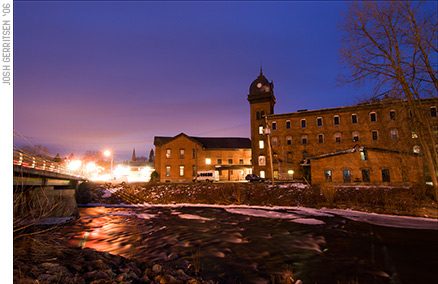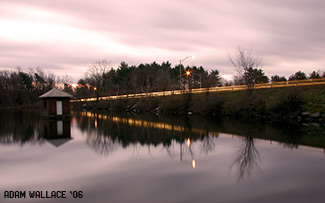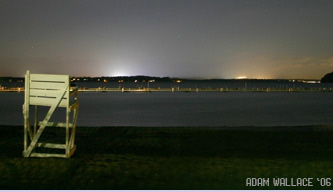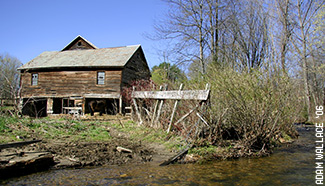On the water
Skidmore research assists local resource planning
Saratoga’s municipal water system is no storied mineral spring, but it gets a lot
of attention from Skidmore students and faculty, who study every angle from watershed
to waterworks to what voters want.
by Kathryn Gallien
originally published in Scope Magazine, Spring 2008 Reflecting the interdisciplinarity of Skidmore’s popular environmental studies program,
the college’s grant-funded, community-based Water Resources Initiative draws students
and faculty into collaborations that tackle real-world problems and produce data of
increasing interest to city politicians, water-plant operators, state regulators,
local environmental groups, and just about anyone who puts a glass under a faucet.
Reflecting the interdisciplinarity of Skidmore’s popular environmental studies program,
the college’s grant-funded, community-based Water Resources Initiative draws students
and faculty into collaborations that tackle real-world problems and produce data of
increasing interest to city politicians, water-plant operators, state regulators,
local environmental groups, and just about anyone who puts a glass under a faucet.
“I love being on the water,” says Alicea Cock-Esteb ’09, a varsity crew member who
last summer took to area lakes and streams in kayaks, canoes, and waders to monitor
water quality in the Saratoga Lake watershed. She worked with environmental-studies
lecturer Kim Marsella and chemistry professor Judy Halstead, who has studied lakes
and streams in Saratoga County for several years and shared her data with many contacts
in the community.
Cock-Esteb says the team took samples to measure salinity, dissolved oxygen, pH,
and other water-quality factors. Halstead and her honors students had earlier detected
high levels of salt and nutrients flowing from Lake Lonely into the Kayaderosseras,
and the summer researchers determined that levels just downstream from the lake were
in fact higher than at any other spot on the creek. Next they want to test Lake Lonely’s
inlets—particularly Spring Run, which serves as the city’s storm-water drainage system.
Spring Run “is probably the least healthy creek we have in the Saratoga Lake watershed,”
says Cock-Esteb.
REAL-WORLD LAB
Like dozens of environmental-studies majors each year, Cock-Esteb did her first water
sampling on the ice of the Loughberry Lake reservoir, in ES 105, “Field Studies in
Environmental Science.” Marsella explains, “We follow the water from its sources to
how it gets to us.” Students drill into the frozen lake in February to measure dissolved
oxygen and take water samples for later study. As the semester progresses, ES 105 students learn about Saratoga geology and the Loughberry
Lake drainage basin, acidification, potential contaminants of surface water, groundwater
movement, water pollution and land use, watershed urbanization, drinking water, and
water rights. In April they tour the city’s water-treatment plant. Tom Kirkpatrick,
the plant’s chief operator, clearly enjoys showing them through the surprisingly beautiful
facility that combines historic architecture with high technology. And he’s impressed
with their knowledge: “They know what they’re doing and how the process works before
they come in.”
As the semester progresses, ES 105 students learn about Saratoga geology and the Loughberry
Lake drainage basin, acidification, potential contaminants of surface water, groundwater
movement, water pollution and land use, watershed urbanization, drinking water, and
water rights. In April they tour the city’s water-treatment plant. Tom Kirkpatrick,
the plant’s chief operator, clearly enjoys showing them through the surprisingly beautiful
facility that combines historic architecture with high technology. And he’s impressed
with their knowledge: “They know what they’re doing and how the process works before
they come in.”
Since his mandate is to test the treated, finished water, he’s pleased to be able
to call on Skidmore researchers, the only people with permission to go out on the
lake and test the raw water. One winter, Kirkpatrick recalls, the city’s tap water
had “a taste and odor problem. You usually don’t get algae bloom in winter, but since
they were going out on the lake I asked them to test for it—and they found it.” Plant
operators responded with treatment they usually apply only in warmer months.
Problems with the lake’s quality are rare, though. “It’s good drinking water,” says
Marsella. But quantity is another matter, especially in the summer, when hot weather
can push the average daily consumption of 4 million gallons to well over 6 million.
Kirkpatr ick warns, “It’s only a five-square-mile watershed. Eventually we’ll outgrow
this.”
WATER POLITICS
Cool clear water has become a local hot-button issue as citizens and public officials
have debated where—and even whether—to tap a supplemental municipal water source for
Saratoga Springs. The Loughberry Lake reservoir was created in 1871 and by all accounts
has served the city well. But in 1988 the state’s Department of Environmental Conservation
issued its Water Quality and Watershed Study of Loughberry Lake, urging the city to
investigate other long-term water resources. Since then the problem has been studied
extensively, and a plan to tap Saratoga Lake has been approved. The issue, however,
is far from settled.

A sampling of Skidmore's local water
studies
"Blessed with Water: Politicizing Resource
Management in a Water Rich Area of
Upstate New York" (2005)
"Boating and Fishing on Saratoga Lake:
Stakeholders' Perceived Threats to
Recreation" (2006)
"Effect of Zebra Mussels (Dreissena
polymorpha) on Turbidity (2006)
"Water Conflicts and Contradictions:
Recreation and Invasive Species in Saratoga
Lake" (2006)
"The Economic Impact of Recreation on
Saratoga Lake and Threats to Its Long Term
Viability: The Perspective of Local Businesses"
(2007)
"The Impact of Pricing Reform on Water
Consumption in Saratoga Springs" (2007)
Newly elected mayor Scott Johnson and public-works commissioner Skip Scirocco have
promised a careful review of the planning that preceded them, but each has questioned
whether an additional water resource is really needed. It was Scirocco’s predecessor,
Tom McTygue, who responded to the DEC recommendation and honchoed a complicated project
entailing an independently conducted study that ultimately pointed to Saratoga Lake
as the best choice to provide a relatively small but important supplement to the city
water supply. Before that plan was acted on, Saratoga County officials launched a
project to tap into the Hudson River upstream of Glens Falls, N.Y., and lobbied Saratoga
Springs to become a key customer. Residents are split about which plan to support,
the city hasn't yet committed to either, and what happens next is anyone’s guess.
The political conflict has added a new dimension to Skidmore’s water research. Julie
Ringer ’07 and Sarah Loomis ’07 dove into the water sourcing issue for their senior
capstone project, which involves all ES majors in local water-related research and
culminates with an Academic Festival presentation for faculty, students, and community
members. “We spent a lot of time learning about the drinking water debate in Saratoga,”
says Ringer, currently an intern with the Union of Concerned Scientists in Cambridge,
Mass. “But no one had ever simply polled residents. So that’s what we did.” With guidance
from government professor Bob Turner, the students telephoned more than 1,000 people,
313 of whom agreed to participate. Forty-six percent of respondents favored using
Saratoga Lake as a future water source, 28 percent preferred the Hudson River plan,
and the rest were undecided or favored another source. A clear majority—60 percent—said
the most important criterion was water quality.
Community interest in the poll was high, Turner says, noting that then-mayor Valerie
Keehn attended the students’ presentation, as did reps from the League of Women Voters,
Friends of the Kayaderosseras, the Saratoga Lake Association, and other groups. Turner
was impressed that his students learned “how to design and execute an original research
project and present their findings to a lay audience. They put all their knowledge
and training into action to produce something of value to the community.”
WATER, WATER EVERYWHERE
Sampling of both water and public opinion are important branches of research in Skidmore’s
Water Resources Initiative, which began three years ago as a way “to better immerse
ES students in the kind of interdisciplinary investigation that solves environmental
problems,” says ES and WRI director Karen Kellogg. WRI’s emphasis on community-based
research dovetails with the college’s mission to instill in students a thirst for
civic engagement and prepare them for lives of responsible citizenship. Kellogg observes
that it has also attracted strong support from the Rathmann, Arthur Vining Davis,
and Mellon foundations as well as local groups like the Saratoga County Soil and Water
Conservatin Committee.
At its monthly meetings the Saratoga County Water Quality Coordinating Committee
receives various reports and presentations—sometimes from Skidmore researchers, whose
information “is helping to provide a comparison over time and from site to site,”
says committee liaison John Hamilton. He adds that down the road the data “should
be useful for analyzing changes that may be occurring to local streams and lakes as
a result of land-use activities.”
Clearly, ES faculty tapped into an area of significant community interest when they
chose water for their research focus. Not only did they have abundant expertise in
water issues, but when the water-source debate took off, “there was a lot still to
learn about both Loughberry and Saratoga Lakes,” says Kellogg. “So we thought we could
really contribute something to the community.”
Students agreed. This year Elizabeth Stoner ’08 and Liz White ’08, working with new
ES faculty member Cathy Gibson, found higher numbers and diversity of snails in Loughberry
Lake than in their comparison site, Lake Desolation, and they suspect that Eurasian
milfoil, an invasive plant that supports algae and benefits from nutrients added to
the lake, plays a role. They also studied the potential impacts of copper sulfate—an
herbicide that the city uses to control algae growth—on sunfish, snails, and insects
in Loughberry. “The results of this study may spur city leaders to evaluate how copper
sulfate treatments are affecting all aspects of the ecosystem that is Loughberry Lake,”
says Stoner. “Sometimes amidst the political debates about water shortages and the
use of Loughberry Lake as a municipal water supply, we forget that it’s an important
resource and home to various fish species, macroinvertebrates, and more.”
In addition to public research reports, the WRI offers project information on its
Web site, designed by Adam Wallace ’06. The site shows a remarkable range of research
and offers a good sense of what professor Bob Turner calls the program’s “adventures
in interdisciplinarity.”
Several WRI projects have taken advantage of Skidmore's geographic-information-systems
center, a resource for faculty and students that also collaborates with community
groups such as Saratoga PLAN, the Saratoga Spa State Park, and the Hudson River Sloop
Clearwater. Students have used GIS to map the geology of the Kayaderosseras Creek watershed,
explore the methodology used to develop the 100-year FEMA flood map for the Saratoga
Lake watershed, and analyze problems that could result from channelized streams.
One eye-catching Web feature is the photographic essay (sampled on these pages) created
by Wallace and Josh Gerritsen ’06 as a senior project. “Art can show a different side
of environmental issues,” explains Gerritsen. “We used our photos to show both natural
and human influences on lakes and streams.” In keeping with the WRI’s stance of political
neutrality, the photographers avoided taking sides in the political debate about water
sourcing. Their aim, says Gerritsen, was “to show residents how diverse and also interconnected
the water around us really is. Perhaps the next time they consider dumping something
harmful into a stream, our project will make them think twice.” A recent project by Hannah Phillips ’09 looked at land that could be developed along
the upper Hudson River, upstream of the proposed intake site for the Saratoga County
water system at Moreau, N.Y. Her build-out analysis found that 41 percent of the area
was developable land.
A recent project by Hannah Phillips ’09 looked at land that could be developed along
the upper Hudson River, upstream of the proposed intake site for the Saratoga County
water system at Moreau, N.Y. Her build-out analysis found that 41 percent of the area
was developable land.
Whether the Hudson is seen as a resource and building site—as opposed, say, to a
natural wonder to be admired and respected—is the kind of question that intrigues
sociologist Rik Scarce, who looks at the different ways people perceive and define
the river. His WRI collaborative research project, with Megan McAdams ’08, explored
shifting meanings of the river from early European contact to the time of the American
Revolution. As “musty old book stuff,” he says, their archival research was “probably
the farthest-flung of any WRI project.” Yet their conclusion that power derived from
the landscape rather than human culture adds an interesting social-psychological perspective
to the WRI discussions. Bob Turner marvels, “It’s fun to have students in one class
all doing different things. Those studying politics or pricing can’t help but be influenced
by those studying development or pollution. You see natural synergies that help inform
each individual project.”
RESEARCH THAT MATTERS
When students share their research results publicly, Kellogg notes, they often come
to grips with the complexity of environmental issues. “They really begin to understand
that while water should clearly be an environmental issue, it’s not just about the
environment. People have other motivations—political, economic, historic, issues of
control. That’s a shocker for them, and an important one.” Equally important, she
says, is the desire to excel that arises “when students understand that the data they
are gathering aren’t just going to be shoved in a drawer. Those data may be used in
community discussions and decision-making.”
By this time next year, Alicea Cock-Esteb will be a senior, readying her research
for public scrutiny and preparing to develop the career in water chemistry that she
knew was right for her back when she took ES 105 (“Literally the first day, when they
went over the syllabus, it felt like this is where I’m supposed to be”). But more
students will soon follow—canoeing, wading, sampling, and measuring—translating their
watershed moments into information and insights for the wider community.